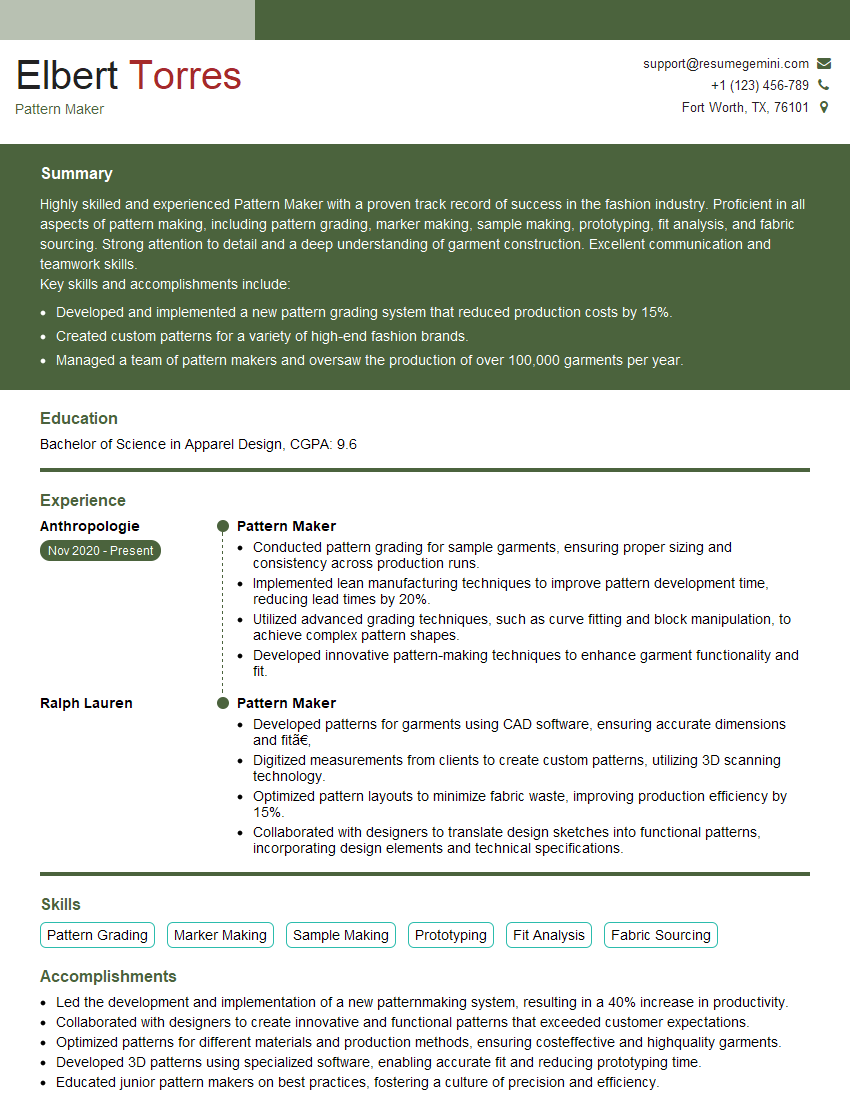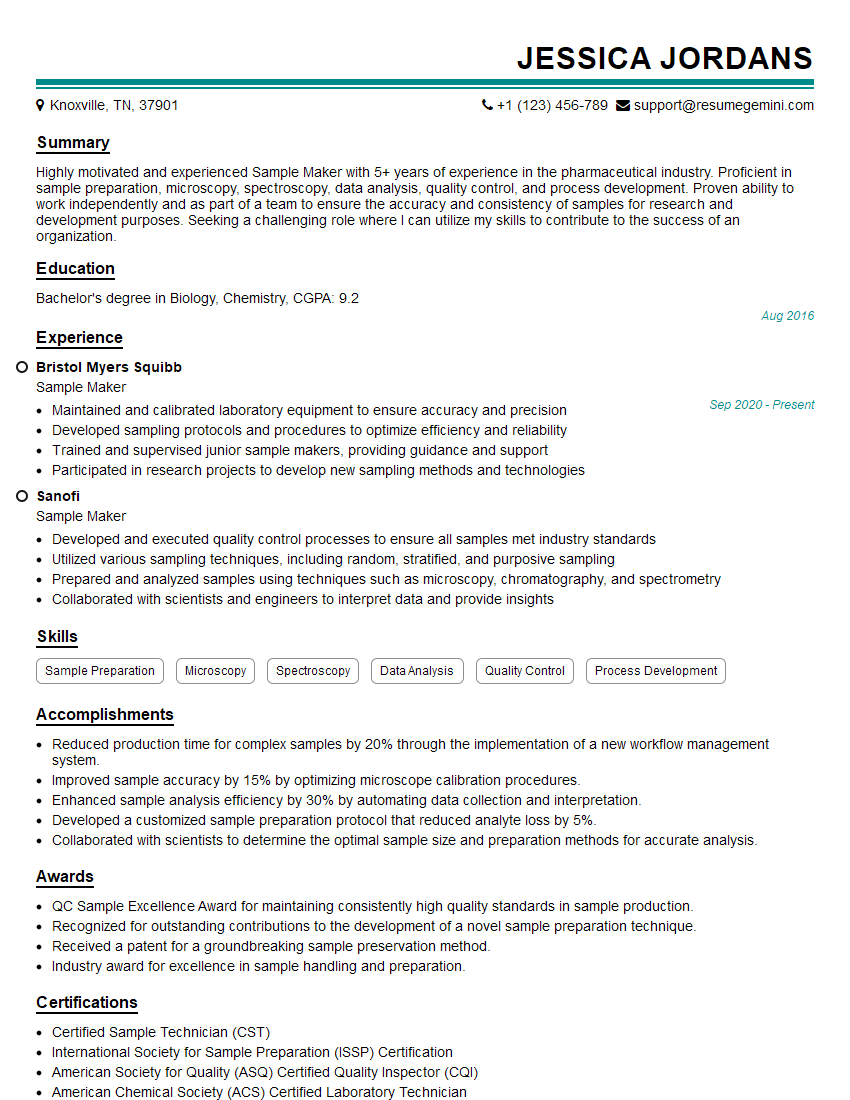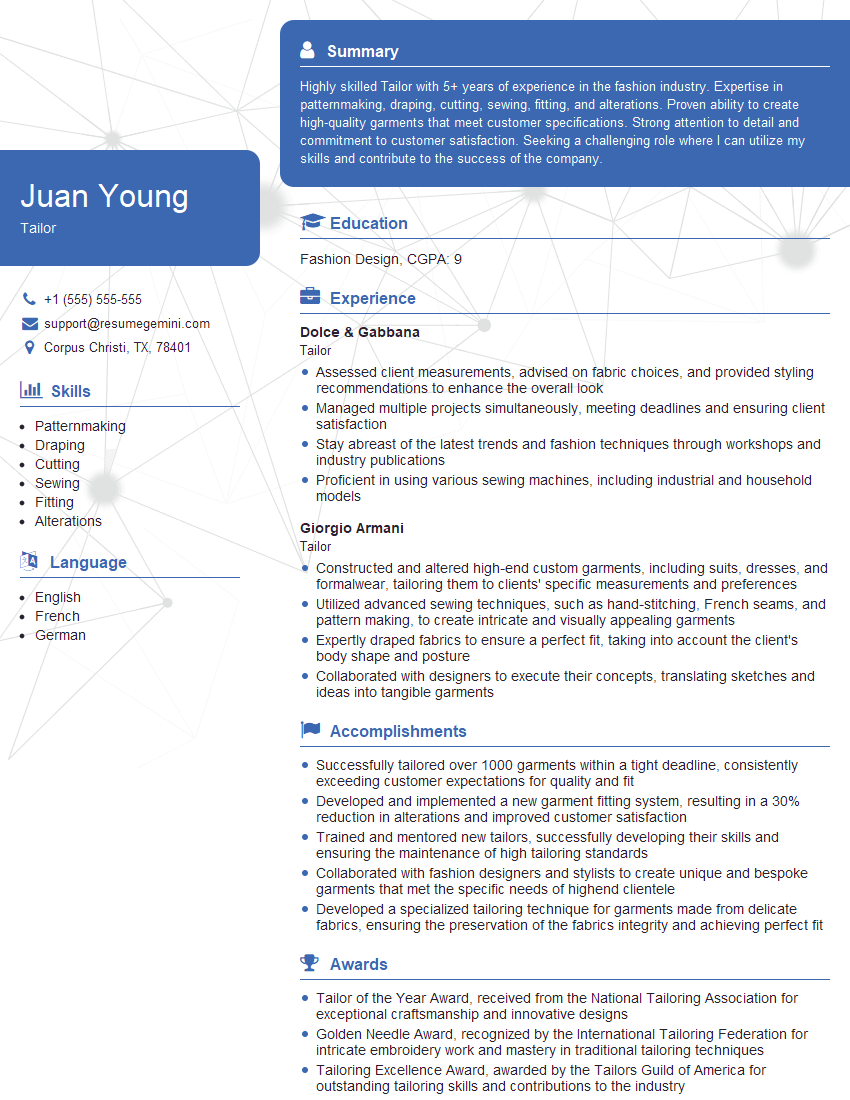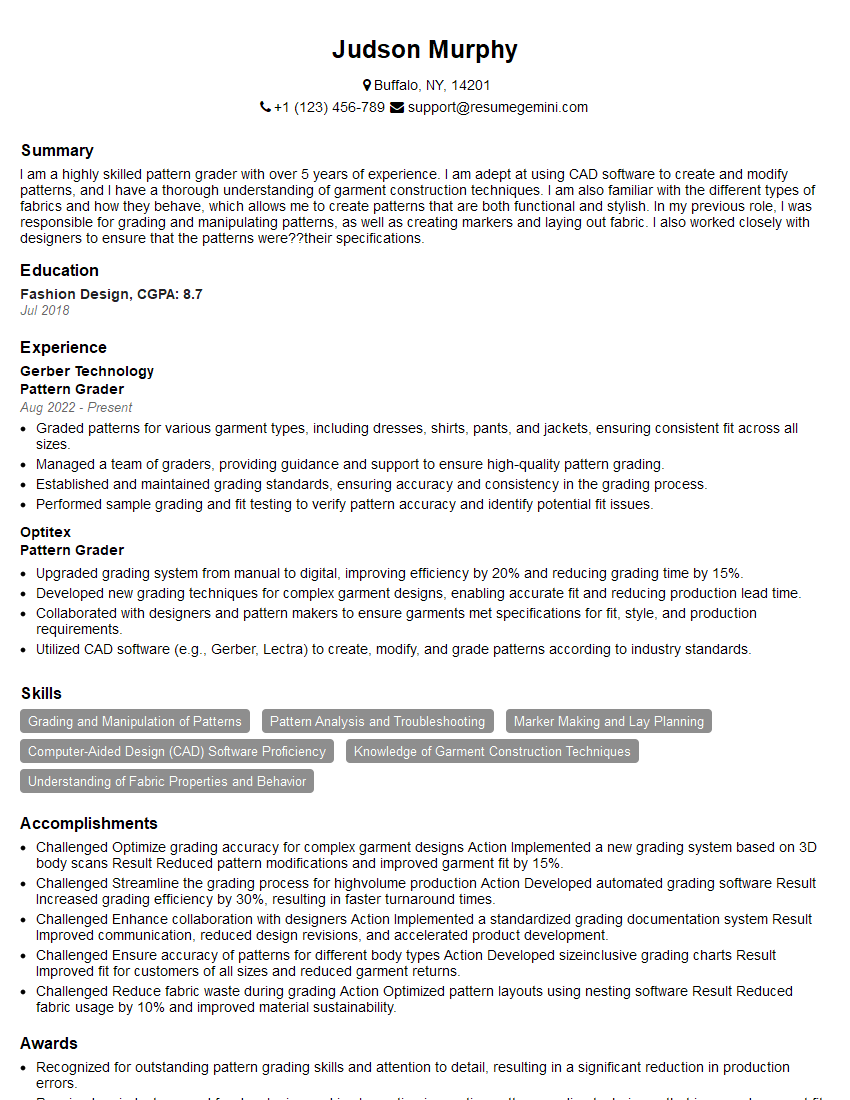Preparation is the key to success in any interview. In this post, we’ll explore crucial Pattern Duplication interview questions and equip you with strategies to craft impactful answers. Whether you’re a beginner or a pro, these tips will elevate your preparation.
Questions Asked in Pattern Duplication Interview
Q 1. Explain the process of pattern duplication.
Pattern duplication is the process of creating multiple copies of a pattern, typically for different sizes or variations of a garment or product. Think of it like making a blueprint for multiple houses – the basic design remains the same, but the dimensions change to accommodate different needs. This involves scaling the original pattern pieces while maintaining their proportions and overall shape. It’s a crucial step in the garment manufacturing process, ensuring consistent sizing and fit across a range of sizes.
The process generally involves accurately measuring the original pattern, calculating scaling factors based on the desired size variations, and then redrawing or digitally manipulating the pattern pieces to reflect the new dimensions. Accuracy is paramount to ensure the final product fits correctly.
Q 2. Describe different methods for pattern duplication.
Several methods exist for pattern duplication:
- Manual Duplication: This traditional method involves using tracing paper and tools like rulers, curves, and French curves to manually trace and redraw the pattern pieces to the new scale. It’s precise but time-consuming, making it less suitable for mass production.
- Digital Duplication (using CAD software): Computer-aided design (CAD) software allows for efficient and precise pattern scaling and manipulation. Software like Gerber Accumark, Lectra Modaris, and Optitex are widely used. You input the original pattern digitally, then the software handles the scaling and adjustments automatically, saving significant time and effort. This method also allows for easy modification and storage of patterns.
- Photocopying/Scanning and Scaling: Though simpler for quick, less precise duplication, this method can distort the pattern and needs careful calibration to ensure accuracy. It’s usually only appropriate for small-scale or less critical projects.
Q 3. What are the key considerations when duplicating a pattern for different sizes?
Duplicating patterns for different sizes requires careful consideration to maintain the garment’s intended fit and shape. Key factors include:
- Grading Rules: These define how much each pattern piece needs to change for each size increment (e.g., adding 1/2 inch to the chest width for each size up). These rules depend on the style and fit of the garment.
- Ease: This extra fabric added to the pattern pieces to allow for comfortable movement and fit should be proportionally adjusted across sizes. Too little ease can result in a tight garment, while too much can create a baggy fit.
- Proportions: Maintain the balance and relationship between different pattern pieces. Scaling uniformly might not always work; certain areas may require more or less adjustment depending on the body’s proportions.
- Balance Points: These are crucial points on the pattern that need to remain in the same relative position regardless of size. Incorrect adjustments can distort the shape or cause fit issues.
For example, when grading a sleeve, you might increase the length proportionally, but the cap height may require a smaller increase to prevent excessive puffiness.
Q 4. How do you ensure accuracy when duplicating patterns?
Ensuring accuracy in pattern duplication involves meticulous attention to detail and the use of appropriate tools and techniques:
- Precise Measurements: Accurate measurements of the original pattern are essential. Use calibrated tools and double-check measurements.
- Consistent Scaling: Use consistent scaling factors across all pattern pieces. In digital duplication, the software handles this, but in manual methods, a consistent scale is vital.
- Regular Checks: Frequently check measurements during the duplication process to catch errors early.
- Test Garments: Creating and fitting test garments from the duplicated patterns is crucial to confirm accuracy and identify any fit issues.
- Using Checklists and Templates: Using checklists to ensure all critical steps are followed and templates to guide the duplication process can greatly enhance accuracy.
Q 5. What software or tools are you familiar with for pattern duplication?
My experience includes working extensively with industry-standard CAD software for pattern making and grading. I’m proficient in Gerber Accumark, Lectra Modaris, and Optitex. I’m also familiar with simpler digital tools like Adobe Illustrator for basic pattern manipulation. Furthermore, I possess a strong understanding of manual techniques using tools like French curves and rulers, which are useful for specialized adjustments or when CAD software isn’t available. My familiarity spans both the digital and traditional approaches, enabling me to adapt to various scenarios and project requirements.
Q 6. How do you handle pattern adjustments during the duplication process?
Pattern adjustments during duplication are frequently necessary to correct fit or styling issues revealed by test garments or to meet specific design needs. These adjustments can be made using a variety of methods, depending on the complexity and the method of duplication. In digital environments, adjustments are made directly on the digital pattern using the software’s tools. In manual methods, these could involve redrawing sections, adding or subtracting seams, and making other precise changes with tools.
For instance, if a test garment reveals the neckline is too tight, I would adjust the neckline curve on the pattern, ensuring that the change maintains the overall balance and structure of the garment. I would similarly adjust the sleeve cap or other areas if needed to improve the fit or drape.
Q 7. Describe your experience with grading patterns.
Pattern grading is a core part of my expertise. It’s the process of systematically adjusting a base pattern to create a range of sizes. I have extensive experience in both manual and digital grading methods. My workflow involves a deep understanding of body measurements, grading rules, and design considerations. This includes analyzing fit issues on test garments and making informed adjustments to the grading rules to ensure consistent fit across the size range.
I’ve worked on numerous projects, grading patterns for various styles of garments—from simple t-shirts to complex tailored jackets. I understand how different fabrics and constructions can affect grading and adjust my techniques accordingly. For example, grading knitwear requires different considerations than grading woven fabrics. Digital grading allows for efficient and accurate scaling, while manual grading allows for more nuanced adjustments based on experience and observation.
Q 8. How do you manage alterations during pattern duplication?
Managing alterations during pattern duplication is crucial for achieving a perfect fit and maintaining the design integrity. It’s like fine-tuning a musical instrument – small adjustments can dramatically impact the final outcome. I approach alterations systematically, starting with a thorough understanding of the required changes. This involves carefully analyzing the original pattern, the desired alteration (e.g., size adjustment, style modification), and the fabric’s properties.
For instance, if I need to enlarge a sleeve, I wouldn’t simply add inches to the existing pattern piece. Instead, I’d use techniques like ‘grading’ the pattern, which involves proportionally increasing the size of each pattern piece to maintain the balance and overall aesthetic. This might involve using specialized software or manually adjusting the pattern pieces, ensuring smooth curves and consistent proportions. I also account for ease allowances, considering how much extra fabric is needed for a comfortable fit and to accommodate the fabric’s drape.
For more complex alterations, such as adding darts or changing the neckline, I’d create a muslin (a test garment) from inexpensive fabric to check the fit and make adjustments before working with the final fabric. This iterative approach minimizes mistakes and ensures the final product accurately reflects the desired design.
Q 9. Explain your understanding of pattern manipulation techniques.
Pattern manipulation techniques are the tools we use to modify and adapt existing patterns. Think of them as the sculptor’s chisels – they allow us to shape and refine the design to achieve unique results. These techniques range from simple adjustments like adding seam allowances or altering lengths, to more advanced methods like manipulating darts, easing curves, and creating new pattern pieces.
- Grading: Systematically increasing or decreasing the size of a pattern.
- Slash and Spread: Cutting and spreading sections of the pattern to widen or narrow areas (e.g., widening a skirt).
- Pivot and Shift: Rotating and repositioning pattern pieces to change the silhouette.
- Adding/Removing Darts: Shifting fullness from one area to another to refine the fit.
- Draping: Using fabric directly on a dress form to create a pattern from scratch, ideal for complex designs.
I’m proficient in all these techniques, and my choice depends on the complexity of the alteration and the desired outcome. For instance, I’d use the ‘slash and spread’ technique for widening a sleeve, but ‘grading’ for a simple size adjustment. The key is to understand the impact of each technique on the overall garment and apply it strategically.
Q 10. What are the common challenges in pattern duplication, and how do you overcome them?
Common challenges in pattern duplication include variations in fabric drape, shrinkage, and pattern matching difficulties. One time, I was duplicating a dress pattern using a silk fabric, which had a considerably different drape than the original cotton. The pattern, which worked perfectly with the cotton, created undesirable wrinkles and folds in the silk.
To overcome these challenges, I employ several strategies:
- Fabric testing: I always pre-wash and test fabrics to account for shrinkage before cutting. This prevents unpleasant surprises later on.
- Muslin mock-ups: Creating test garments ensures the pattern fits the chosen fabric and allows for adjustments.
- Understanding fabric properties: Knowing the drape, stretch, and other characteristics of the fabric is crucial. This allows me to choose the right pattern manipulation techniques and adjustments.
- Pattern matching techniques: Careful planning and precise cutting are essential for seamless pattern matching in prints and stripes. I often use specialized tools and techniques to ensure accuracy.
Troubleshooting is a key skill. I approach each problem systematically, analyzing the cause and implementing appropriate solutions. My experience allows me to anticipate potential issues and proactively address them.
Q 11. How do you ensure the integrity of the original pattern during duplication?
Ensuring the integrity of the original pattern is paramount. It’s akin to preserving a priceless artifact. My approach involves meticulous documentation and precise replication methods. I start by creating a digital copy of the original pattern if possible. This allows me to make alterations without affecting the original. If working with a physical pattern, I use high-quality tracing paper and carefully transfer all markings, including notches, grainlines, and seam allowances.
I also meticulously label all pattern pieces, including size and any modifications made. Using a consistent system of labeling prevents confusion and ensures accuracy. Storage is vital; I store original patterns and their duplicates in a safe, organized manner to prevent damage or loss.
Beyond simple copying, I also understand the importance of understanding the design principles behind the original pattern. By analyzing the construction and understanding the designer’s intent, I can more effectively duplicate and adapt the pattern for different fabrics or styles.
Q 12. Explain your experience with different fabric types and their impact on pattern duplication.
Different fabric types significantly influence pattern duplication. It’s like trying to build with different materials – wood, metal, or plastic each require different techniques. The drape, stretch, and weight of the fabric all affect the final garment. A pattern perfectly suited for a crisp cotton might not work well with a fluid silk.
- Woven fabrics: These have a stable structure, making them relatively easy to work with. Cotton, linen, and wool fall under this category.
- Knit fabrics: These have stretch and drape differently, requiring adjustments to ease allowances and pattern construction.
- Stretch fabrics: These necessitate the use of stretch patterns or modifications to the original pattern to ensure a comfortable fit.
My experience encompasses a wide range of fabric types, and I always account for the specific characteristics of the fabric when duplicating a pattern. For example, I might need to add seam allowances for fabrics with a tendency to fray or adjust the pattern pieces for fabrics with significant stretch.
Q 13. How do you prioritize speed and accuracy in pattern duplication?
Prioritizing speed and accuracy in pattern duplication requires a strategic approach. It’s like a well-orchestrated production line. Accuracy never compromises speed; instead, they complement each other. I achieve this through a combination of efficient techniques and technological tools.
Firstly, I utilize efficient pattern-making techniques. This includes using digital pattern-making software to quickly modify and grade patterns. For complex alterations, creating well-planned muslin mock-ups saves time in the long run by catching mistakes early on. Precise cutting and sewing techniques minimize wasted time and material.
Secondly, using appropriate technology plays a significant role. Digital pattern-making software greatly accelerates the process. Precise measuring tools and well-maintained equipment further contribute to speed and efficiency, allowing for the creation of high-quality duplicates in a timely manner.
Q 14. Describe your experience working with different pattern-making systems.
My experience spans various pattern-making systems, both manual and digital. I’m proficient in using industry-standard software such as Gerber Accumark and Lectra Modaris. These systems offer advanced features like automated grading, pattern manipulation tools, and 3D simulations, significantly streamlining the process and enhancing accuracy.
In addition to digital systems, I have extensive experience with traditional methods, including manual drafting and using physical pattern-making tools. This broad experience allows me to effectively adapt to different workflows and environments. I’m not only skilled in using the software but also in understanding its limitations and knowing when traditional methods might be more suitable. For instance, in some cases, manual adjustments to the pattern are more precise and efficient than using a software solution.
Q 15. How familiar are you with industry standards for patternmaking?
My familiarity with industry standards for patternmaking is extensive. I’m proficient in various grading systems, including those based on industry-standard measurements and those specific to particular brands. I understand the importance of accurate measurements, consistent grading rules, and the use of standardized terminology to ensure clarity and prevent errors. For example, I’m well-versed in using slopers (basic block patterns) as a foundation, understanding the modifications needed for different body types and garment styles. I also adhere to best practices concerning the use of industry-standard software and hardware for pattern creation and manipulation. This adherence to standards minimizes discrepancies between patterns and ensures consistent quality throughout the production process.
I regularly stay updated on changes in the industry through professional development courses and industry publications, ensuring my techniques align with the latest best practices. This keeps me abreast of new technologies and methodologies, maximizing efficiency and accuracy.
Career Expert Tips:
- Ace those interviews! Prepare effectively by reviewing the Top 50 Most Common Interview Questions on ResumeGemini.
- Navigate your job search with confidence! Explore a wide range of Career Tips on ResumeGemini. Learn about common challenges and recommendations to overcome them.
- Craft the perfect resume! Master the Art of Resume Writing with ResumeGemini’s guide. Showcase your unique qualifications and achievements effectively.
- Don’t miss out on holiday savings! Build your dream resume with ResumeGemini’s ATS optimized templates.
Q 16. How do you work with a team during pattern duplication projects?
Teamwork is crucial in pattern duplication projects. I believe in open communication and collaboration. My approach involves clearly defining roles and responsibilities from the outset, ensuring everyone understands their contributions. For instance, in one project involving the duplication of a complex menswear suit pattern, we had a team leader, a grader, a marker maker, and a sample sewer. Each person had specific tasks, but we held regular meetings to discuss progress, identify potential roadblocks, and make adjustments as needed. We leverage tools like shared cloud storage for pattern files and project documentation to maintain transparency and efficiency.
I actively encourage constructive feedback and contribute to a supportive team environment. I find that by valuing every team member’s expertise, we collectively identify and resolve potential issues more effectively, ultimately leading to a higher quality final product. We also utilize visual aids such as digital mockups and physical samples to facilitate understanding and collaboration.
Q 17. Describe your experience with quality control in pattern duplication.
Quality control is paramount in pattern duplication. My approach involves a multi-stage process. First, a thorough review of the original pattern is conducted, checking for accuracy, completeness and identifying any potential issues. This involves verifying the measurements, grainlines, notches, and other markings. Second, during the duplication process, I meticulously check each stage – grading, marking, and any necessary adjustments – for any discrepancies. This often involves making test garments in muslin to verify the fit and proportions.
Finally, after the duplicated pattern is completed, a comprehensive quality check is carried out, which includes comparing the original and duplicated patterns, reviewing the grading accuracy across all sizes, and ensuring that all markings and notations are consistent. This helps to minimize errors and ensure that the final product adheres to the required standards. I meticulously document all quality control checks, providing a traceable record of the process.
Q 18. How do you troubleshoot issues that arise during pattern duplication?
Troubleshooting in pattern duplication requires a systematic approach. When issues arise, I begin by identifying the root cause. For example, if a graded pattern doesn’t fit correctly, I’ll analyze the grading rules, check for errors in measurements, and examine the original pattern for any inherent flaws. I may re-grade the pattern, adjust seam allowances, or modify the pattern’s design features. Often, careful examination of the problem area, along with a review of the production notes helps pinpoint the cause.
I leverage my understanding of garment construction and fit to analyze discrepancies. I may need to consult with other team members – seamstresses or designers – to gain different perspectives. Sometimes, it requires recreating a part of the process to pinpoint inconsistencies. My documentation of each step is vital during troubleshooting because it enables me to trace the issue back to its origin.
Q 19. What are some common errors made in pattern duplication, and how can they be avoided?
Common errors in pattern duplication include inaccurate grading, incorrect marking of pattern pieces, and inconsistent seam allowances. Inaccurate grading can result from errors in calculations or neglecting specific body measurements which lead to ill-fitting garments. Incorrect markings can cause confusion during garment construction, resulting in assembly errors. Inconsistent seam allowances lead to inconsistencies in the final garment.
These errors can be avoided through meticulous attention to detail, using precise measurement tools, consistently following established grading rules, and maintaining clear and accurate pattern markings. Implementing thorough quality control checks at each step helps to detect and correct these errors before they impact the final product. Employing the use of templates and standardized processes also significantly reduces the occurrence of errors. Regular calibration of tools and software also significantly reduces such errors.
Q 20. How do you adapt to changes and new information during a pattern duplication project?
Adaptability is key in pattern duplication. I’m comfortable working with changes and new information, considering it an integral part of the design process. If a change in design specifications occurs mid-project, I adjust the pattern accordingly, working closely with the design team to ensure the changes are seamlessly integrated into the existing design. This typically involves modifying the existing pattern, re-grading if necessary, and creating new patterns to accommodate new design elements.
I prioritize open communication to stay informed of any modifications and adjust my workflow accordingly. My experience using digital tools enables me to swiftly adapt to evolving project requirements. I can make quick alterations to the digital pattern and have the updated version ready for the team swiftly.
Q 21. Describe your experience with using computer-aided design (CAD) for patternmaking.
My experience with CAD for patternmaking is extensive. I’m proficient in several leading CAD software packages and utilize them for all aspects of pattern creation and manipulation. This includes creating base patterns, grading, and making design adjustments. CAD provides advantages such as increased accuracy, efficiency, and scalability compared to traditional manual methods. For example, I can easily make precise adjustments to a pattern across multiple sizes using CAD functions.
The use of digital pattern pieces greatly improves efficiency by reducing the time spent on manual processes, and the storage and retrieval of the digital patterns is greatly streamlined. CAD also facilitates seamless collaboration with the design and production teams through shared digital files, aiding in better communication and coordination.
Q 22. Explain your understanding of different pattern drafting methods.
Pattern drafting involves creating a two-dimensional representation of a three-dimensional garment. Several methods exist, each with its strengths and weaknesses. I’m proficient in both manual and digital methods.
- Manual Drafting: This traditional method uses tools like rulers, curves, and French curves to create patterns on paper. It requires a strong understanding of garment construction and body measurements. It’s excellent for learning the fundamentals and making precise adjustments. For example, I’ve used manual drafting to create perfectly fitted bodice patterns, adjusting for different bust points and waistlines based on individual measurements.
- Digital Drafting: Software like Adobe Illustrator, Pattern Design Software, or CAD systems are used to create and manipulate patterns electronically. This offers speed, precision, and the ability to easily manipulate and scale patterns. I frequently use this method for larger production runs, allowing me to quickly generate many pattern variations with minimal effort. Imagine needing 50 variations of a dress; digital drafting makes this a practical possibility.
- Draping: This is a three-dimensional approach where fabric is draped on a dress form to create the pattern directly. It’s particularly useful for creating unique and innovative designs. I have employed draping to create intricate, flowing designs that would be difficult to achieve through other methods. It allows for a more intuitive understanding of how fabric falls and drapes, vital for complex designs.
My expertise spans all three, allowing me to select the optimal approach based on project requirements and design complexity.
Q 23. How do you manage your time effectively when working on multiple pattern duplication projects?
Managing multiple pattern duplication projects effectively involves a structured approach. I leverage project management techniques like prioritizing tasks based on deadlines and complexity. I break down large projects into smaller, manageable tasks. For instance, if I have three projects – a simple t-shirt, a complex coat, and a series of children’s dresses – I’ll prioritize the coat due to its complexity and potentially longer timeline. The t-shirt, being simpler, can be tackled quickly, and the children’s dresses can be managed as a batch project given their similarities.
I utilize tools like project management software (Asana, Trello) to track progress, deadlines, and resource allocation. Regular review and adjustment of the schedule are crucial, allowing me to adapt to unexpected challenges or delays. Clear communication with clients regarding timelines and potential adjustments is key. Think of it like a well-orchestrated symphony; each instrument (project) needs careful timing and coordination to create a harmonious whole.
Q 24. How do you stay up-to-date with the latest trends and technologies in pattern duplication?
Staying current in pattern duplication requires a multi-faceted approach. I actively participate in industry conferences and workshops to learn about new technologies and techniques. I subscribe to relevant industry publications and online resources. Following key figures and companies on social media provides valuable insights into innovative practices. Attending webinars and online courses allows for continuous learning and skill development. I also regularly explore new software and hardware solutions and experiment with innovative techniques to incorporate the latest technologies into my workflow.
Staying updated isn’t just about new software; it’s about understanding emerging trends in fabric technology, sustainability practices within the industry, and evolving design aesthetics. All of these factors influence pattern design and duplication.
Q 25. Describe a time you had to solve a complex problem related to pattern duplication.
I once faced a challenging project involving duplicating a vintage pattern with significant damage and missing sections. The original pattern was for a complex, intricately designed evening gown. Many pieces were torn, faded, and some were missing entirely. Solving this involved a methodical approach.
- Analysis: I meticulously examined the existing fragments, carefully studying the construction and seaming details. I analyzed the remaining stitch lines, fabric grain, and any markings to deduce the original design.
- Reconstruction: Using my knowledge of garment construction and historical pattern techniques, I painstakingly pieced together the missing sections. I used similar vintage patterns for reference, making inferences and educated guesses where necessary.
- Testing and Refinement: I created a test garment using my reconstructed pattern. I made necessary adjustments based on the fit and overall look of the test garment, ensuring accuracy in the final product.
This project highlighted the importance of patience, attention to detail, and a deep understanding of historical pattern making techniques. The resulting gown was a testament to this careful and meticulous approach.
Q 26. How do you maintain accuracy when scaling patterns up or down?
Maintaining accuracy when scaling patterns is crucial. Both manual and digital methods offer ways to ensure accuracy. In manual scaling, using a proportional scaling method— enlarging or reducing based on a consistent ratio – is essential. For example, if I’m scaling up a pattern by 20%, every dimension (length, width) needs a 20% increase.
Digital methods offer more advanced tools. Software applications allow for precise scaling using a scaling factor. They also allow for adjustments to specific areas based on fabric drape and fit considerations. For example, you might need to adjust the sleeve cap height when increasing the size to maintain a proper fit. Double-checking measurements at each stage is critical regardless of the method.
To further ensure accuracy, I always create test garments at the scaled size. This allows for detecting and correcting any errors before committing to a full production run. This extra step saves time and resources in the long run.
Q 27. How do you handle inconsistencies in original patterns?
Inconsistencies in original patterns are common. These can range from simple drafting errors to more complex issues related to inconsistent grading or missing pieces. My approach involves careful analysis and problem-solving.
- Identify the Inconsistencies: I begin by thoroughly examining the pattern for any discrepancies, such as mismatched seam allowances, inaccurate markings, or gaps in the pattern pieces.
- Analyze the Cause: I determine the likely cause of the inconsistencies. Is it a drafting error, a problem in grading the pattern, or simply a mistake made during the pattern’s creation?
- Implement Corrections: I implement the necessary corrections, often relying on my knowledge of garment construction and pattern-making principles. If needed, I might research similar patterns for reference or use my own drafting skills to create missing pieces.
- Test the Corrected Pattern: I always create a test garment from the corrected pattern to validate that the adjustments have resolved the inconsistencies and that the garment fits and functions correctly.
Addressing inconsistencies requires a combination of technical skill, creative problem-solving, and a keen eye for detail. My experience in pattern making allows me to handle these situations effectively and produce consistent, accurate results.
Q 28. Explain your experience with documenting and archiving patterns.
Documenting and archiving patterns is essential for maintaining accuracy, efficiency, and traceability. My approach combines both digital and physical methods for comprehensive archiving.
- Digital Archiving: I scan patterns digitally, preserving high-resolution images. This allows for easy retrieval and duplication when needed. I also use a digital database with detailed descriptions, including measurements, grading information, fabric specifications, and any notes related to the pattern’s design or construction.
- Physical Archiving: I store physical copies of patterns in a clean, organized manner, ensuring proper labeling and protection from damage. This provides a backup in case of digital failures.
- Metadata and Organization: For both physical and digital archives, I employ a standardized naming system and detailed metadata to facilitate easy searching and retrieval. This includes information like the pattern’s name, date of creation, designer, and any relevant notes.
A robust archiving system ensures the preservation of intellectual property, facilitates efficient project management, and allows for easy access to patterns for future use or reproduction. This is especially important when handling multiple projects simultaneously.
Key Topics to Learn for Pattern Duplication Interview
- Fundamental Algorithms: Understanding core algorithms like string matching (e.g., Knuth-Morris-Pratt, Boyer-Moore), substring search, and dynamic programming techniques crucial for efficient pattern duplication detection.
- Data Structures: Mastering relevant data structures such as tries, suffix trees, and hash tables to optimize pattern searching and comparison processes. Understanding their strengths and weaknesses in different scenarios is key.
- Time and Space Complexity Analysis: Critically analyze the efficiency of different algorithms and data structures used for pattern duplication. Be prepared to discuss Big O notation and how it applies to your chosen methods.
- Practical Applications: Explore real-world examples of pattern duplication, such as plagiarism detection, DNA sequencing, data compression, and anomaly detection in network traffic. Be ready to discuss how different algorithms are suited for these tasks.
- Error Handling and Robustness: Discuss strategies for handling noisy data, partial matches, and edge cases that may arise during pattern duplication. Demonstrate your understanding of how to build robust and reliable solutions.
- Optimization Techniques: Explore techniques like parallel processing, indexing, and heuristics to optimize the speed and efficiency of pattern duplication algorithms, especially for large datasets.
- Pattern Variations and Transformations: Consider scenarios involving variations in patterns (e.g., case-insensitive matching, allowing for minor variations) and how to adapt algorithms to handle these complexities.
Next Steps
Mastering Pattern Duplication is a highly valuable skill, opening doors to exciting opportunities in various fields like software engineering, data science, and bioinformatics. A strong understanding of these concepts significantly enhances your candidacy for roles requiring sophisticated problem-solving and algorithmic thinking. To maximize your job prospects, create an ATS-friendly resume that showcases your expertise effectively. We recommend using ResumeGemini, a trusted resource for building professional and impactful resumes. ResumeGemini provides examples of resumes tailored to Pattern Duplication to help you present your skills in the best possible light.
Explore more articles
Users Rating of Our Blogs
Share Your Experience
We value your feedback! Please rate our content and share your thoughts (optional).
What Readers Say About Our Blog
Hello,
We found issues with your domain’s email setup that may be sending your messages to spam or blocking them completely. InboxShield Mini shows you how to fix it in minutes — no tech skills required.
Scan your domain now for details: https://inboxshield-mini.com/
— Adam @ InboxShield Mini
Reply STOP to unsubscribe
Hi, are you owner of interviewgemini.com? What if I told you I could help you find extra time in your schedule, reconnect with leads you didn’t even realize you missed, and bring in more “I want to work with you” conversations, without increasing your ad spend or hiring a full-time employee?
All with a flexible, budget-friendly service that could easily pay for itself. Sounds good?
Would it be nice to jump on a quick 10-minute call so I can show you exactly how we make this work?
Best,
Hapei
Marketing Director
Hey, I know you’re the owner of interviewgemini.com. I’ll be quick.
Fundraising for your business is tough and time-consuming. We make it easier by guaranteeing two private investor meetings each month, for six months. No demos, no pitch events – just direct introductions to active investors matched to your startup.
If youR17;re raising, this could help you build real momentum. Want me to send more info?
Hi, I represent an SEO company that specialises in getting you AI citations and higher rankings on Google. I’d like to offer you a 100% free SEO audit for your website. Would you be interested?
Hi, I represent an SEO company that specialises in getting you AI citations and higher rankings on Google. I’d like to offer you a 100% free SEO audit for your website. Would you be interested?
good





